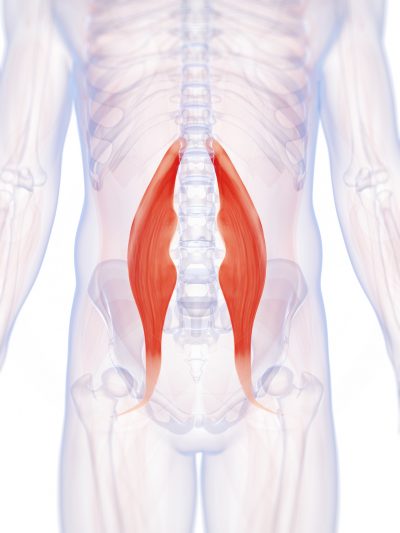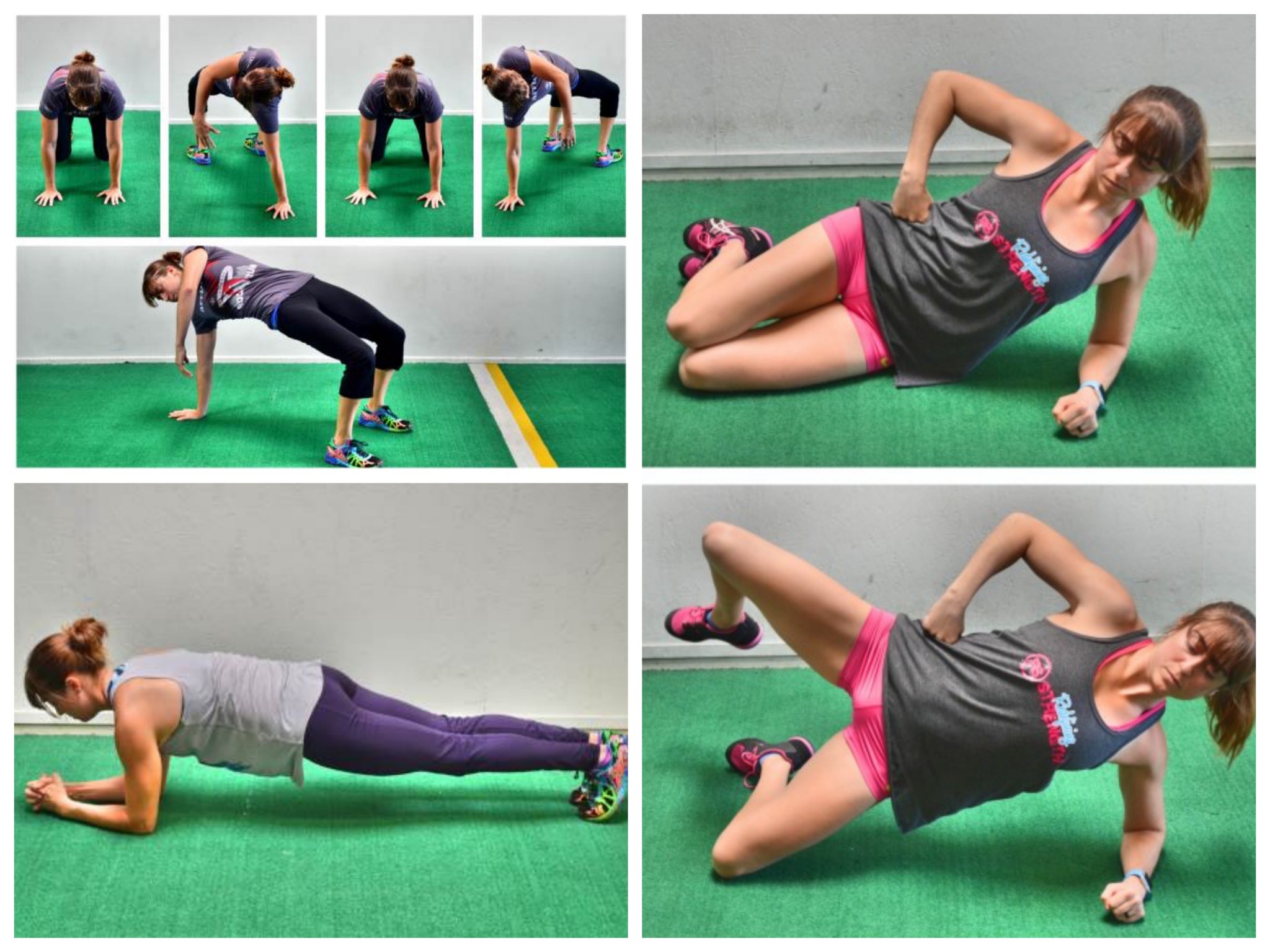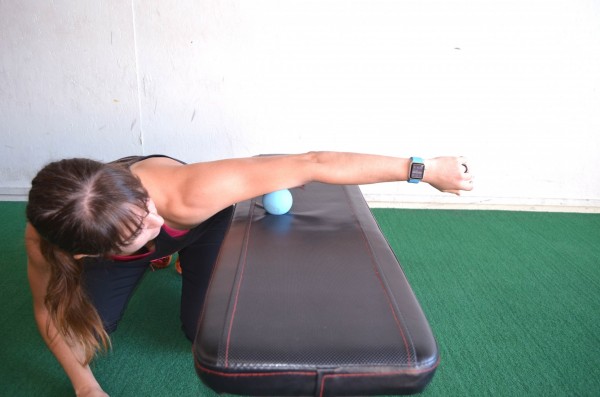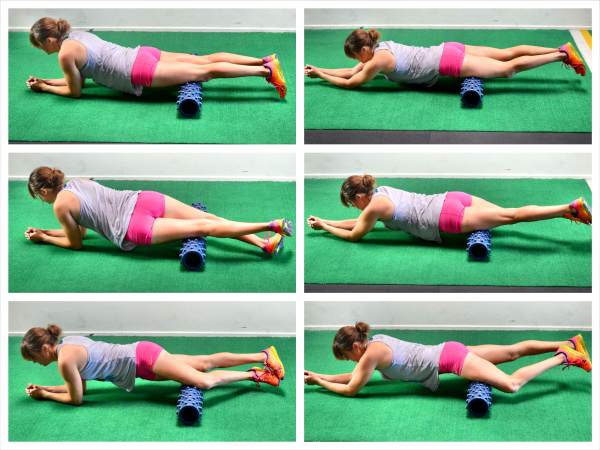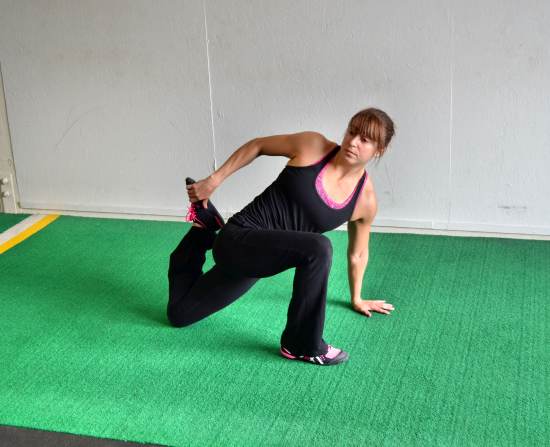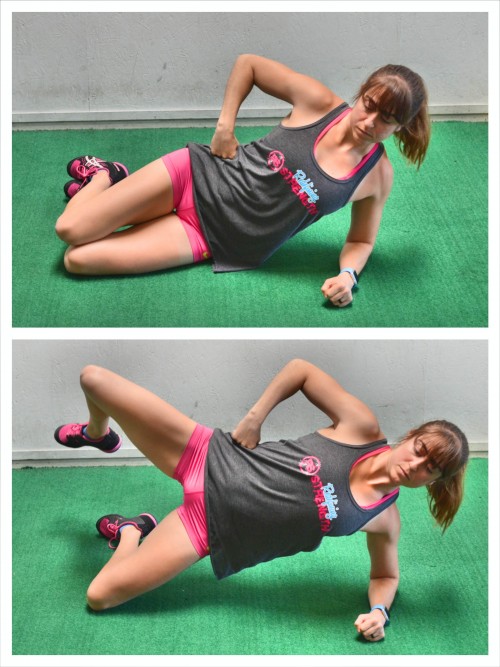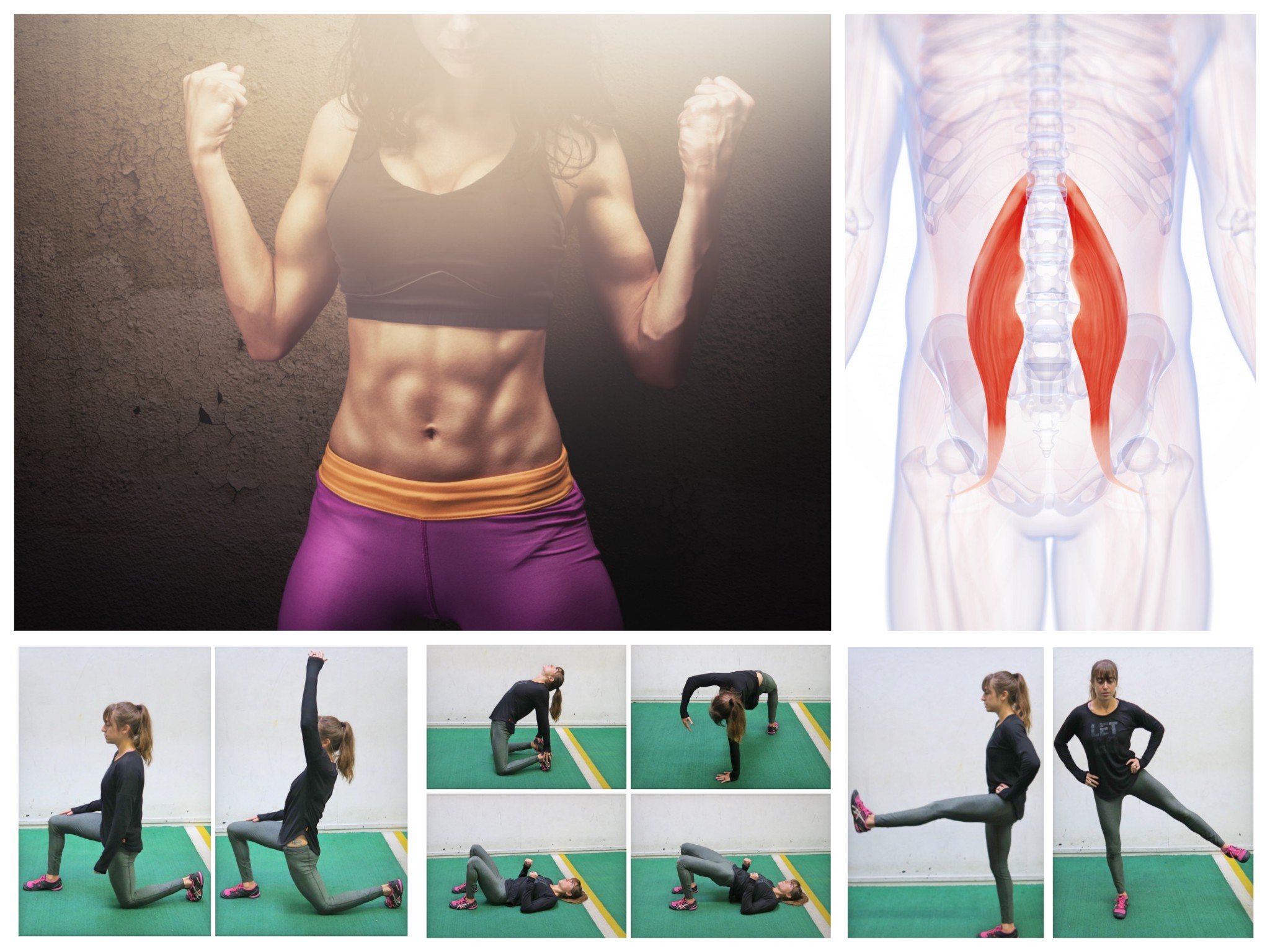
Unlock Your Hips And Activate Your Glutes
We’ve all know that we sit too much during the day and that sitting may be killing us.
And while moving more is important, your movement needs to REVERSE the effects of sitting.
You’ve got to make sure that you loosen tight muscles and get those muscles that become weak and inactive from sitting activated and working correctly again.
This is why I constant harp on improving hip mobility AND working on glute activation!
If you sit a lot during the day, your hips are tight from being in constant flexion (aka bent!). This tightness causes your glutes to often shut off, which means all of that squatting and lunging and deadlifting may not actually be working those butt cheeks!
It may mean you’re actually potentially risking pain and injury because other muscles are engaging and working so that you can squat and deadlift and lunge. Muscles that SHOULDN’T and CAN’T really handle the load!
Wonder why your low back so often hurts? Or why you only feel your quads during some of these compound moves?
It may be because your glutes aren’t actually working and engaging because they aren’t activated! And why aren’t they activated?
Because your hips are locked up!
To unlock your hips and activate your glutes, I like to do these 3 moves basically DAILY!
(And if you are looking for a complete program to unlock those hips and activate those glutes check out this AMAZING one – Unlock Your Hip Flexors!)
Half-Kneeling Hip (and Quad!) Stretch – I do this stretch as often as possible. It is the perfect way to reverse the effects of sitting and even start to activate your glutes. You can do a few different variations and hit your hips from a couple of different angles and even really stretch out your quad as well.
One HUGE key though to getting this stretch to actually work though is ENGAGING YOUR GLUTE! Too often people do this and don’t ACTUAL extend their hip because they lean forward or simply arch their low back.
If you don’t engage your glute and actually focus on extending your hip, guess what?! You don’t actually unlock your hips and you don’t really reverse all of the effects of sitting!
So no matter which version you pick, make sure to truly engage your glute and extend your hip and not simply your low back. If you are starting out, the version below is a great place to start! From there you can add in the quad stretch by grabbing your back foot or placing it up on a bench.
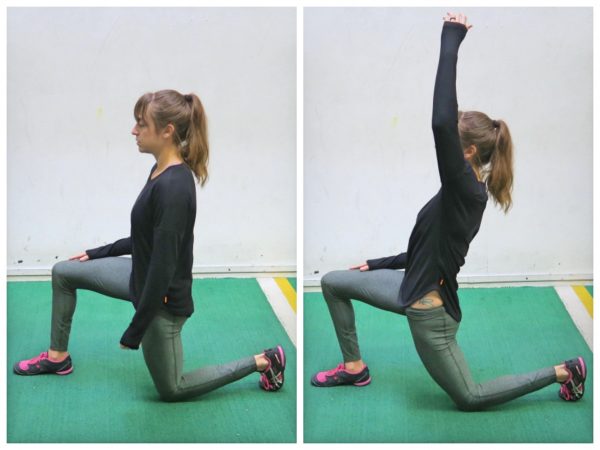
To do the Basic Half-Kneeling Hip Stretch, start half kneeling on the ground. Flex your back foot and squeeze your glute as you drive your back hip forward. Reach your hand up overhead so that you feel a nice stretch down the hip of the back leg. You can reach both hands up or simply the hand on the side that is back.
Squeeze the glute of your back leg so that you are actually fully extending your back hip and not simply arching your back. If you just hyperextend your low back, you will just be perpetuating the problem. Make sure you are truly extending your hip.
Breathe as you hold and reach your hands backward overhead or turn this into a dynamic stretch by releasing and then repeating the stretch.
You can also reach your arms to the side over your front leg if you want to hit your hip from a different angle and stretch your TFL and even the muscles of your back that help you bend to the side.
Leg Swings – If you ask any of my in-person clients, they’ll tell you I make them do this one basically daily along with the Half-Kneeling Hip Stretch. I LOVE this one because it not only works on balance and activates the muscles that stabilize your feet and lower legs, but it also wakes up your core, activates your glutes AND opens up your hips.
And it does all of these things in different planes of motion, which means you’ll be mobilizing your hips so you can move well in every direction!
There are three main variations of the Leg Swing I use; however, you can really swing in any direction. Just make sure to really engage the glute of the standing leg to help you balance and even use the glute of the other legs to swing, especially on the rotational one!
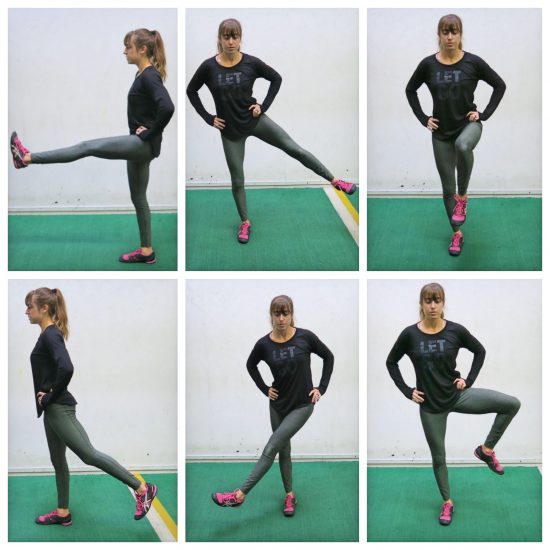
To do the 3-Way Leg Swings, start standing on one foot. Feel your foot gripping the ground and engage the glute of the standing leg to help you balance. Brace your abs and stand up nice and tall.
Keeping both legs fairly straight, but not locked out, begin to swing the other leg forward and backward. Swing from the hip, don’t just bend your knee and kick your lower leg. The bigger your swings are, the more your standing leg will have to work to balance.
Do not hold on to anything as you do this move. If you need to at the beginning, just perform smaller swings and tap your foot down as needed to reset and stabilize. You can hold onto a wall if you want to remove the balance element and instead just focus on mobilizing the hip, but remember that you are then taking out balance work and even building some extra core stability.
Complete all reps of the forward/backward swing then, still balancing on the same leg, switch to lateral swings. For the lateral swings, swing the leg up to the right and then to the left in front of your standing leg. You may even feel the outside of that glute working to raise the leg up as you swing it. The bigger your swing, the more you will open up your hip and force your standing leg to work hard to balance.
After performing the lateral swings, bend the knee of the leg you’ve been swinging to 90 degrees and perform rotational swing.
To do rotational swings, bring the bent knee in front of you and then open it out to the side. Bring the knee back forward, keeping the leg bent the entire time. Really focus on opening from the hip with this move. You should really feel the glute of the standing leg working as you rotate. The more your rotate, the harder the move will be, but also the more you will open your hips and get your glutes activated.
Once you complete all three swings, switch to the other side and do all three swings.
If you do this move correctly, you will feel your foot, calf and even your shin muscles working to balance. You will also feel your glute and core engaging as you swing your leg to open your hip.
Again start with a more basic balancing pose if you can’t maintain balance or perform smaller swings. The whole point of this move is to improve your mind-body connection and get things activated so you can balance.
Bridging – I don’t care if you do a Camel Bridge, Tabletop Bridge, Basic Glute Bridge or any other variation of the Bridge…If you aren’t doing some sort of bridge almost daily, you are missing out on a great chance to not only improve your hip extension but also activate your glutes!
Unlocking your hip flexors and keeping them unlocked isn’t only about stretching. Because if you stretch and then go right back and sit, you’ll simply tighten everything back up.
BUT if you actually get the muscles activated and working and STRENGTHEN through the range of motion you’ve established, you can actually improve your mobility, unlock your hip flexors and prevent and alleviate low back and hip pain (as well as even knee pain among other things!).
No matter how advanced an exerciser you are, you should always include a Basic BODYWEIGHT Glute Bridge in your routine…I know I do.
A. Because it is important to always return to basics and establish/maintain your mind-body connection.
B. Because with bodyweight exercises we are often actually able to contract our glutes harder AKA really make sure they are activated and working correctly!

Just a refresher on that Basic Bodyweight Glute Bridge…
To do the Basic Glute Bridge, lie on your back and bend your knees and put your feet flat on the ground. Your feet should be about hip-width apart. You may need to adjust your exact foot positioning based on how tight or mobile your hips are. You can move your feet slightly away or slightly closer to your butt, but just make sure you don’t move them so far away that you feel your hamstrings taking over.
Bend your elbows to 90 degrees so that only your upper arms are on the ground. This will help you really be able to drive down with your elbows, upper arms and back to help you bridge straight up instead of pushing yourself backward.
Then bridge up, driving through your heels and upper back and arms to lift your glutes up off the ground. Drive your hips up as high as possible, squeezing your glutes hard as you brace your abs. Keep your belly button drawn in so you don’t hyperextend your back. Focus and consciously squeeze your glutes at the top.
When you bridge, do not push backward off your heels. Make sure you are driving straight up and that your knees aren’t caving in. Even think about driving your knees forward over your toes to help extend your hips and prevent you from pushing yourself backward.
Squeeze your glutes for second or two at the top and lower all the way back down to the ground before repeating. Do not rush through the move.
OH and I also want to mention…Glute Activation and unlocking your hip flexors not only means reversing the effects of sitting so you prevent and alleviate injury and can lift more and run faster…
But it can also help with that LOWER BELLY POOCH!
Did you know that tight hip flexors can actually contribute to that hard to get rid of lower belly pooch!?! Well they can!
All the more reason to unlock those hips and get those booty cheeks working correctly.
For some essential flows and movements you NEED to be including in your workout routine, check out this program – Unlock Your Hip Flexors!
–> Click Here To Learn More About How To Unlock Your Hip Flexors! <–

